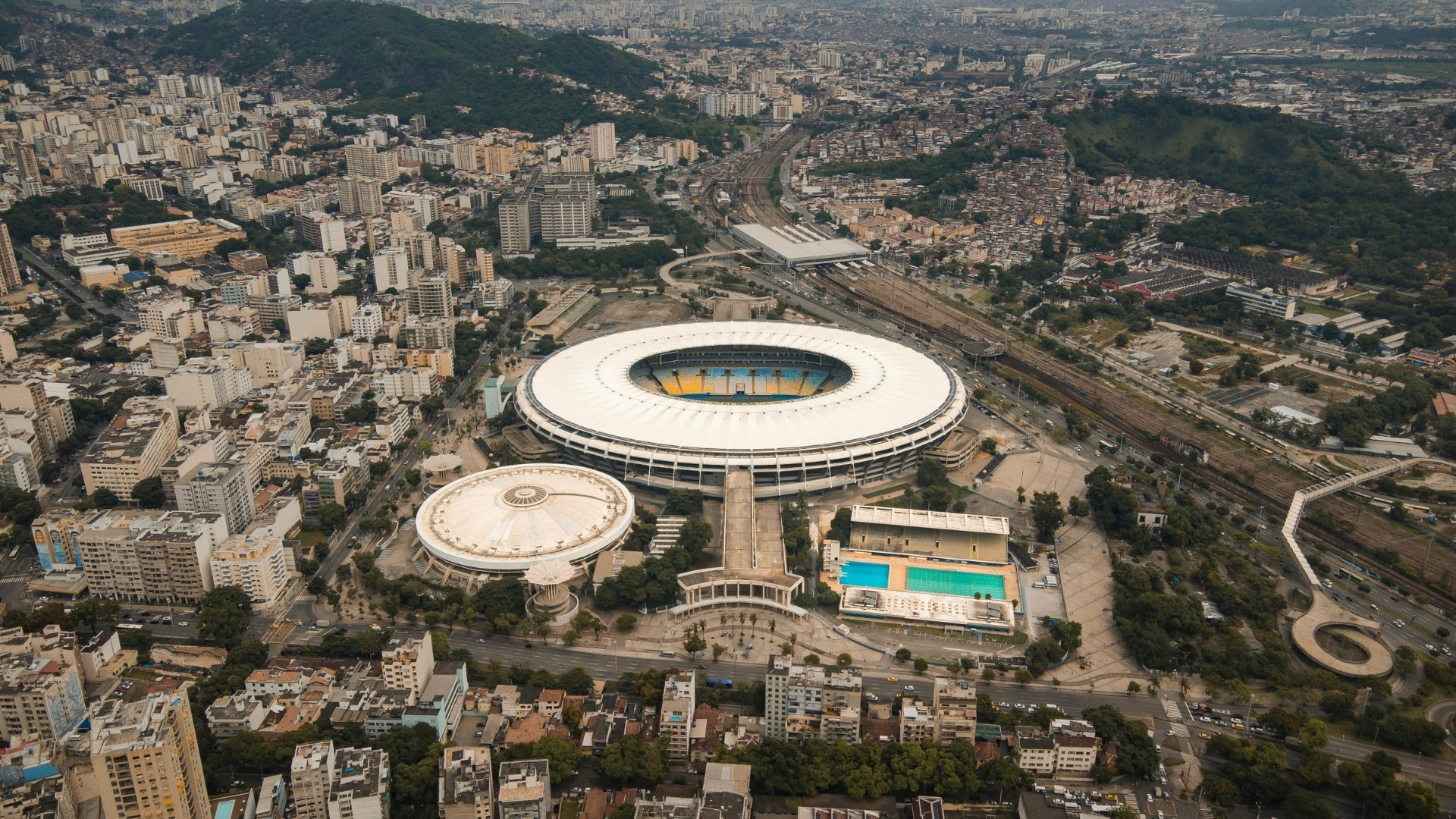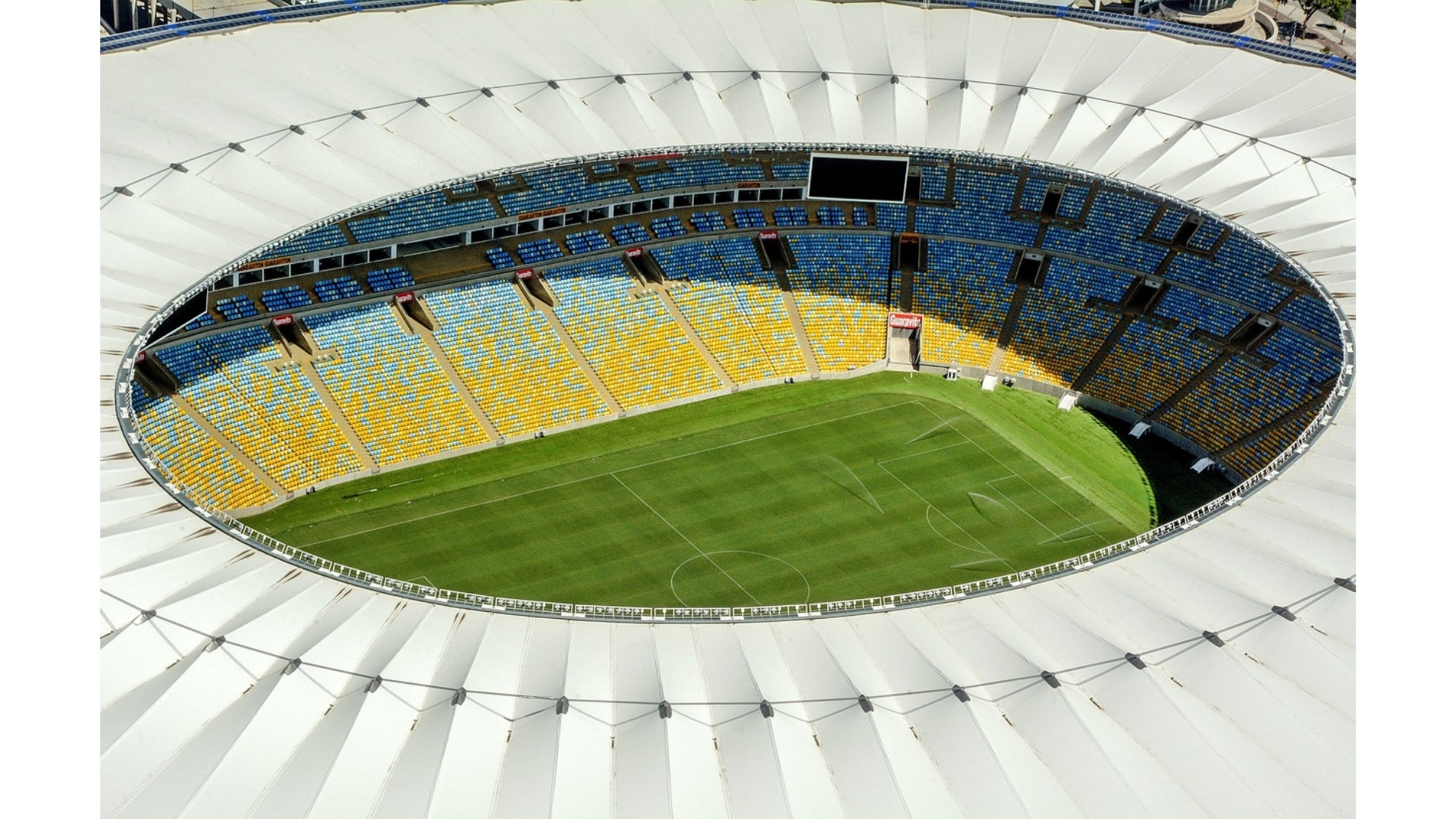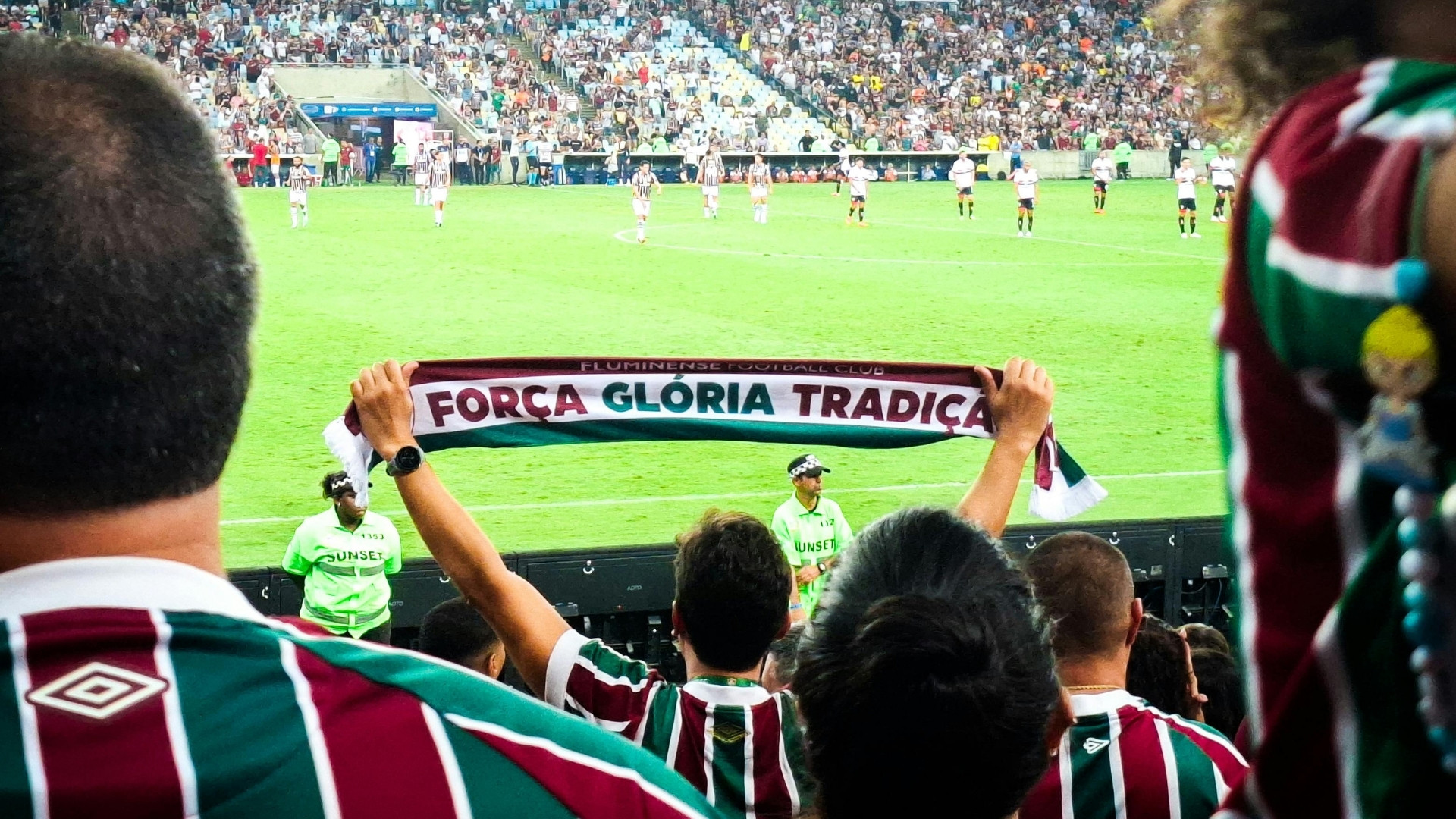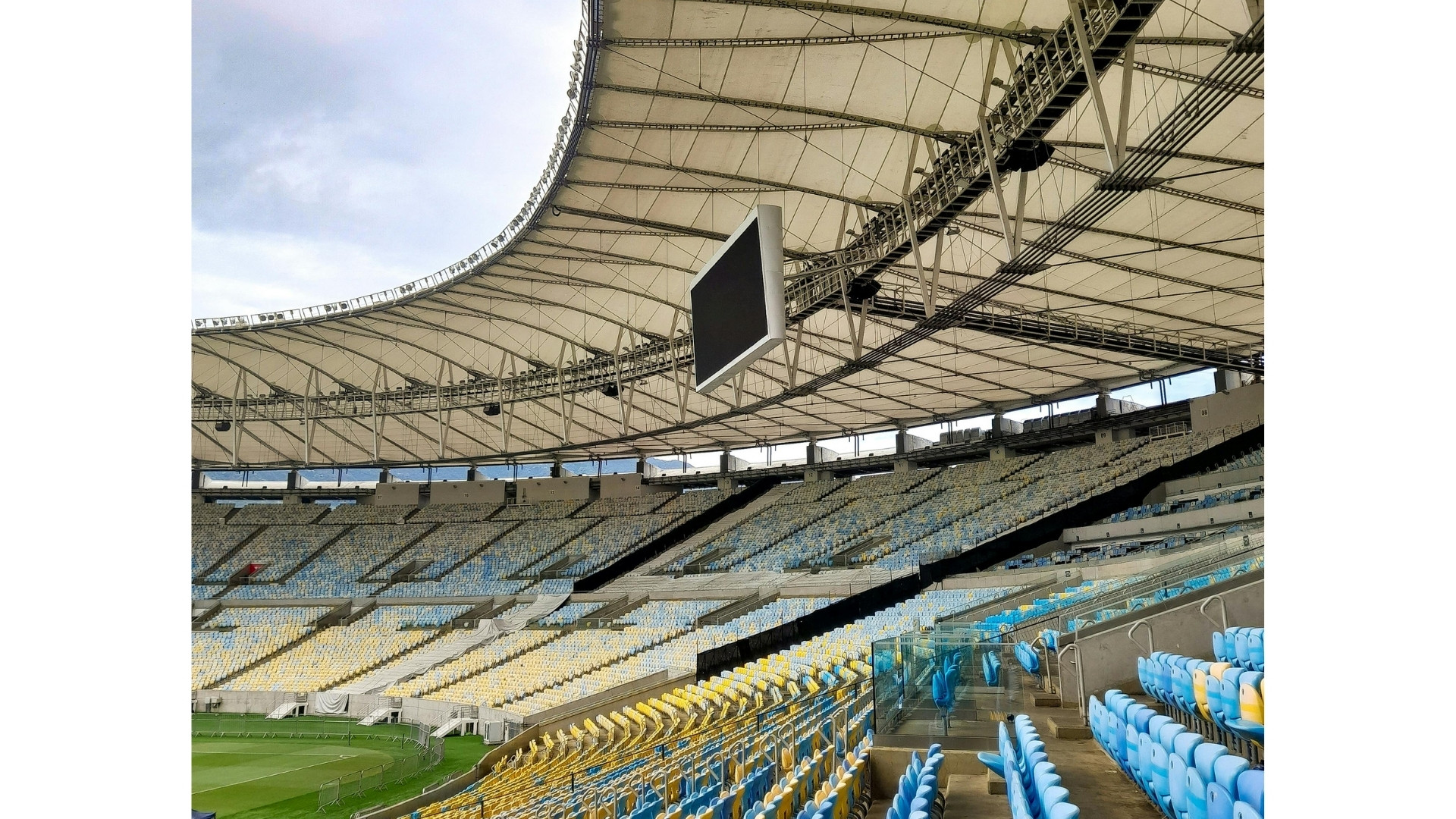
The Maracanã Stadium is the sacred temple of Brazilian football, where legends like Pelé scored their most iconic goals and where the nation’s passion for the beautiful game comes alive with every match.
Highlights:
- Step onto the hallowed pitch where two World Cup finals and the 2016 Olympic Games were hosted, feeling the energy of nearly 80,000 passionate fans.
- Walk through the players’ tunnel and sit in the team dugout, imagining the pre-match tension of football’s greatest stars.
- Explore the museum filled with priceless memorabilia showcasing the rich history of Brazilian football and the stadium’s iconic moments.
Tickets & Prices
Ready to walk in the footsteps of football legends? Grab your ticket to Maracanã Stadium and join the fascinating 40-minute tour that takes you behind the scenes of Brazilian football history. You’ll get access to the museum, changing rooms, and areas typically reserved for players and officials.
My advice? Book your tickets online before you go. This saves you from potential disappointment, especially during busy tourist seasons or when matches are scheduled. The stadium offers different rates for adults, children, seniors, and even special discounts for Brazilian residents, so check what works best for your group.
Tours
The standard Maracanã tour packs a lot into 40 minutes! You’ll wander through the same tunnel players use on match day, sit in the actual dugout where managers have celebrated victories and mourned defeats, explore the changing rooms, and visit the press conference area where football’s biggest stars face the media.
Football fanatics should consider upgrading to the match-day experience. These special packages include a pre-match visit to local fan zones with a knowledgeable guide who’ll explain the chants and traditions. You’ll also get a welcome drink and – the main event – tickets to watch teams like Flamengo or Fluminense play while surrounded by some of the world’s most passionate fans. Trust me, the atmosphere is unlike anything you’ve experienced at sporting events elsewhere.
Opening Hours
Maracanã welcomes visitors throughout the week during standard business hours, with tours running regularly. On match days, though, they adjust the schedule significantly – for example, when Flamengo played Vasco at 5:45 pm on March 8th, tours only ran from 9:00 am to 12:45 pm with the last entry at 11:45 am.
Always check the official website before heading out, as hours change frequently depending on match schedules. The tour itself lasts about 40 minutes, but I’d recommend setting aside at least an hour for your visit to fully appreciate each area without rushing. Remember that the last tour always ends at least three hours before stadium gates open for matches.

What to See and Do
There’s something magical about walking into Maracanã Stadium. As one of football’s most hallowed grounds, this isn’t just another tourist stop – it’s a pilgrimage for sports fans. Here’s what to experience when you visit this legendary arena.
Walk Through the Players’ Tunnel and Feel the Anticipation
The moment you step into the players’ tunnel at Maracanã, you’re walking the same path as legends like Pelé, Zico, Ronaldo, and countless other football greats. The tunnel experience is surprisingly emotional – the walls seem to echo with decades of pre-match tension, team talks, and the thunderous roar of expectant fans.
As you emerge from the tunnel onto the edge of the pitch, you’ll feel what countless players have felt before big matches. Take a moment here to imagine nearly 80,000 passionate Brazilian fans creating that famous wall of sound. It’s one thing to see the stadium on TV during World Cup matches; it’s entirely different to stand here in person and soak in the atmosphere.
Pro tip: This is one of the best photo spots in the stadium, so have your camera ready!
Sit in the Dugout and Channel Your Inner Manager
Ever wondered what it feels like to be a world-class football manager? The dugout at Maracanã gives you that chance. Take a seat where legendary coaches have orchestrated famous victories and suffered agonizing defeats.
From this vantage point, you get a player’s-eye view of the pitch – noticing details you’d never see from the stands. The dugout seats are surprisingly comfortable (at least by stadium standards), and you can almost hear the echoes of coaches barking instructions and players anxiously waiting to be substituted in.
It’s a uniquely intimate perspective on the game that most fans never experience. You might find yourself instinctively reaching for an imaginary clipboard to diagram your winning strategy!
Explore the Museum and Relive Iconic Moments
The Maracanã museum isn’t huge, but what it lacks in size it makes up for in historical significance. The carefully curated collection brings together important pieces of Brazilian football history, from vintage jerseys and boots to photographs and videos of legendary matches.
Don’t miss the display commemorating Pelé’s 1,000th goal, which happened right here at Maracanã in 1969. The exhibits do an excellent job of explaining the stadium’s central role in Brazilian culture – this isn’t just a sports venue but a national symbol.
The museum offers a fascinating glimpse into the 1950 World Cup final (known as the “Maracanazo”), when Brazil’s expected victory turned into a shocking defeat against Uruguay. You can see how this single match profoundly impacted Brazilian football and national identity.
Visit the Changing Rooms and Press Conference Area
The changing rooms at Maracanã have been modernized over the years, but they’ve maintained their historical essence. These walls have witnessed pre-match rituals, halftime team talks, post-match celebrations, and heartbreaking defeats.
As you walk through the changing area, imagine the tension before a World Cup final or the electric atmosphere of derby day between local rivals Flamengo and Fluminense. The spaces are surprisingly intimate, bringing you closer to the human side of the beautiful game.
Nearby, you can visit the press conference room and sit where football’s biggest stars have faced journalists after their performances. Try sitting in the hot seat yourself – it’s a fun photo opportunity and gives you yet another perspective on the football experience.
Experience a Live Match with Passionate Local Fans

If you can time your visit right, nothing compares to experiencing Maracanã during an actual match. The stadium transforms from a historical monument into a living, breathing cathedral of football passion.
Local matches featuring teams like Flamengo (Brazil’s most popular club) or Fluminense create an atmosphere that has to be experienced to be believed. The singing, chanting, and rhythmic drumming create a carnival-like environment that’s uniquely Brazilian.
For the full experience, book a match-day package that includes a pre-game visit to local fan zones with a guide who can explain the chants, rivalries, and traditions. Even if you’re not typically a sports fan, a match at Maracanã is a cultural experience that offers insight into Brazilian passion and identity.
Insider tip: Wear neutral colors unless you’re specifically supporting one team, and be prepared for a loud, energetic experience. The most passionate fans (organized supporter groups called “torcidas”) typically gather behind the goals.
Take in the Architecture and Stadium Views

Beyond the football-specific areas, take some time to appreciate Maracanã’s architecture. Originally built for the 1950 World Cup and renovated several times since (most recently for the 2014 World Cup and 2016 Olympics), the stadium is a fascinating blend of historical significance and modern design.
Head to the upper levels for spectacular views not just of the pitch but of Rio de Janeiro itself. On clear days, you can spot Christ the Redeemer and Sugarloaf Mountain in the distance – a reminder of the stadium’s place in Rio’s iconic cityscape.
The current capacity of around 78,000 makes Maracanã still one of the largest stadiums in South America, though it’s worth noting that in its original configuration, it once held nearly 200,000 people for the 1950 World Cup final – still the largest crowd ever to attend a football match.
Directions
Getting to Maracanã couldn’t be easier – the subway drops you right at its doorstep! Just hop on the metro and get off at Maracanã station, which puts you practically at Gate A for pedestrians. This is by far the easiest route, especially on match days when traffic gets chaotic.
If the subway isn’t your thing, the SuperWay service also stops at Maracanã station. Driving?
Head for Gate 2 where you’ll find parking, though I’d avoid this option on match days unless you enjoy sitting in traffic.
Numerous bus routes serve the area too, connecting from across Rio. The stadium sits at Avenida Rei Pelé (West Radial) s/n – a name any taxi driver will recognize.
Nearby Places
Quinta da Boa Vista Park combines history and nature just minutes from Maracanã. After the roar of the stadium, this peaceful park offers a welcome change of pace with its National Museum and Zoo. The former imperial gardens make for a perfect afternoon stroll.
UERJ (State University of Rio de Janeiro) sits right next to the stadium. Pop in to see its interesting modernist architecture and maybe grab a coffee at one of the campus cafés. The energy of student life here creates a nice complement to the sporting atmosphere of Maracanã.
Tijuca Forest, just a short drive away, provides an incredible natural escape from urban Rio. One of the world’s largest urban rainforests, it offers hiking trails and waterfalls that feel worlds away from the concrete and crowds of the stadium.
São Cristóvão Market buzzes with northeastern Brazilian culture. The food here is fantastic – sample regional specialties you won’t find in tourist areas. On weekends, the market comes alive with music and dancing, offering yet another dimension of Brazilian culture.
Imperial Palace Museum houses a fascinating collection of Brazil’s royal history. The former residence of the Portuguese royal family provides a glimpse into the country’s imperial past through historical artifacts, elegant furniture, and impressive artwork.
Did you know that: (5 Interesting Facts!)
- The Maracanã Stadium once held a record-breaking crowd of nearly 200,000 spectators during the 1950 World Cup final between Brazil and Uruguay, making it the largest audience ever for a football match.
- The stadium was officially named after Brazilian journalist Mário Filho, who was instrumental in its construction and known as “the crowd creator,” though most people know it simply as Maracanã.
- Besides sporting events, Maracanã has hosted legendary musical performances by artists like Madonna, The Rolling Stones, Paul McCartney, and Tina Turner, as well as two papal masses by Pope John Paul II.
- Pelé scored his famous 1,000th career goal at Maracanã in 1969, cementing the stadium’s place in football history.
- The stadium underwent a complete renovation for the 2014 World Cup, reducing its capacity from approximately 200,000 to 78,000 seats, but improving safety and comfort standards.
History
An almost 75-year timeline of the iconic Maracanã Stadium:
- 1947: Construction begins on what would become Brazil’s largest stadium, intended to host the 1950 FIFA World Cup.
- 1950: Maracanã Stadium officially opens, still partially under construction, just in time for the World Cup. Brazil suffers the shocking “Maracanazo” defeat to Uruguay in the final match.
- 1966: The stadium is officially named after journalist Mário Filho, though it continues to be popularly known as Maracanã.
- 1969: Pelé scores his 1,000th career goal at the stadium, further cementing its legendary status in football history.
- 1989: The stadium hosts the decisive match of the Copa América, where Brazil defeats Uruguay to win the tournament.
- 1992: A section of the upper stands collapses, resulting in three deaths and prompting safety concerns.
- 2000: Maracanã hosts the first FIFA Club World Championship final.
- 2007: The stadium undergoes renovations to host the Pan American Games opening and closing ceremonies.
- 2013-2014: Major renovations transform Maracanã into a modern arena for the 2014 FIFA World Cup, significantly reducing capacity but improving facilities.
- 2016: Maracanã hosts the opening and closing ceremonies of the Summer Olympic Games, as well as football finals.
- Present Day: The stadium remains Brazil’s football temple, hosting major matches and serving as home to Rio’s biggest clubs, Flamengo and Fluminense.
FAQ
How long does the Maracanã Stadium tour take?
The standard tour runs for 40 minutes – just enough time to see everything without feeling rushed. You’ll visit the museum, changing rooms, press area, and get to walk through the players’ tunnel.
Can I visit Maracanã Stadium on match days?
Absolutely! But tours run on a modified schedule, ending at least three hours before kickoff. For instance, during the Flamengo vs. Vasco match, tours only ran until 12:45 pm for a 5:45 pm game. Better yet, grab a match-day package and experience the real magic of Maracanã with thousands of passionate fans.
Which teams play their home games at Maracanã?
Flamengo and Fluminense both call Maracanã home for their major matches. If you get the chance to catch a Flamengo game, do it – they draw the largest, most passionate crowds in Brazil.
Is the Maracanã tour wheelchair accessible?
Yes! The stadium has good accessibility with ramps, elevators, and designated pathways. Visitors with mobility impairments can access most areas of the tour, though some sections may have limited access.
What is the best time to visit Maracanã Stadium?
Weekday mornings tend to be quietest if you want a more peaceful experience. But for the full Maracanã magic, nothing beats attending an actual match – especially a derby between local rivals.